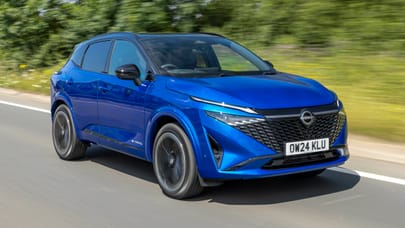
Good stuff
Base-level kit, comfortable cabin, quiet engine
Bad stuff
Ordinary to drive, rather slow, no real USP
Overview
What is it?
This is the second generation Vauxhall Grandland, aimed at the likes of the Ford Kuga and the Hyundai Tucson and the Kia Sportage and the Nissan Qashqai and the Peugeot 3008 and the Volkswagen Tiguan and we need a breath.
The second version is longer, wider and taller than the first one, which was introduced back in 2017 to replace the Zafira after everyone decided they didn’t like MPVs anymore.
This new one is more stylish, with the firm's signature mask-of-Zorro front end. It’s strangely brash for a Vauxhall – the company name on the tailgate even lights up. There’s no hiding what you’re driving in a car park at night.
This petrol one gets mild hybrid assistance, but if you're feeling all futuristic there's an electric version too. It's called the... Grandland Electric.
Mild hybrid, eh?
Oh yes, what a treat. It combines a 134bhp 1.2-litre three-cylinder turbo petrol with a 28bhp electric motor, teeny little battery and a six-speed dual clutch transmission.
The hybrid bit will help you get going and scavenges charge under braking, and will allow the engine to turn off for extended periods. You can even do your parking using the e-motor. Shh...
Vauxhall claims up to 50 per cent of your journey around town will be done with the engine off, which the Grandland can sustain at speeds of up to 84mph (not on the high street, we hope)... for a grand total of one kilometre at a time. Right.
Let's not kid ourselves though: all the energy ultimately comes from the fuel tank. The set-up actually works quite well and we got around 38mpg out of the car in winter driving – not as close to the official 50mpg as we got on our first test, but not calamitous.
How does it drive?
It’s not fun, but it’s impressive how much speed it can take into a corner. Where the Electric washes out into understeer, this one will cling grimly on. You won’t be slinging it down country lanes, but it’s nice to know there's some grip hiding down there.
Likewise the ride is much better in this version, despite lacking the Electric’s fancy suspension. It’s less finicky over imperfections and doesn’t feel as heavily laden... because it isn't. Lighter to the tune of half a tonne, you see. This small petrol engine business could be the future.
What's it like inside?
It’s good to see Vauxhall finally having a bit of a go in here, because for the past few years it’s been left well behind by its Peugeot stablemate. And given that you spend most of your time sat inside the thing rather than looking at it, that matters.
And it feels a big improvement on its predecessor. The centrepiece is the dual screen setup, with a 10-inch digital instrument panel and 10- or 16-inch widescreen infotainment display, both of which look sharp and are impressive on the eye too. It’s also a step up in terms of material quality, with a proper premium feel.
How much is it gonna cost me?
Prices start at just shy of £35k. That gets you into a base spec Grandland, rising to over £38k for the full bells ‘n’ whistles top spec.
That makes it cheaper than the equivalent 3008, Sportage and Kuga; the latter being the best-driving of the lot. Given the volume of standard kit we can see why people might go for this, but we still reckon the others give you more bang for your buck. Pop for your pound?
Add in that the Qashqai is even more keenly pitched on price... suddenly the Grandland finds itself between a rock and a hard place.
Our choice from the range

What's the verdict?
The second generation of Vauxhall Grandland is an improvement on the first, but there's nothing groundbreaking here. Sure, it looks smarter and comes well equipped, but we doubt it’s going to earn too many second glances. Even with that strapping front end. In all honesty we’d have liked Vauxhall to be a bit more daring with it to really state its case over the Qashqai and other mid-size rivals.
That said, it drives alright and the cabin feels up to scratch for the money. The petrol version handles better than the electric one, doesn’t come with baked in range anxiety, and will dispatch the mundane everyday stuff just as easily. Just don't ask any more of it.







